Earlier this year I was invited to be part of Graphic, an event at the Sydney Opera House that describes itself as “a festival of visual storytelling”. On discovering that Matt Groening, creator of The Simpsons and the most successful cartoonist in history, would also be in attendance, I said yes straight away.
My acceptance came with a condition: that I would also be invited to the fancy party they would no doubt throw for Matt Groening, because I planned to hide in a corner and tweet about how I was at a party with Matt Groening.
Later, we received an email from the festival people:
“Mr Groening has agreed to do an interview for the Guardian, however he has only agreed to this interview if Mr Dog is to be the interviewer and write the piece … Matt told me what a huge fan he is of First Dog. They’ll have a great time.”
There are two challenges in doing an interview like this. Firstly, as a cartoonist, I’m not an interviewer. And secondly, how do I make this interview about Matt Groening when all I want to do is talk to him about how MY NEW BEST FRIEND MATT GROENING IS A BIG FAN OF MY WORK?!
Let’s get that part out of the way first.
First Dog: Obviously I have to ask this, but why did you want to talk to me?
Matt Groening: I just checked you out, I love your cartoons … You made me want to come out of retirement – your stuff is really inspiring, I like it a lot.
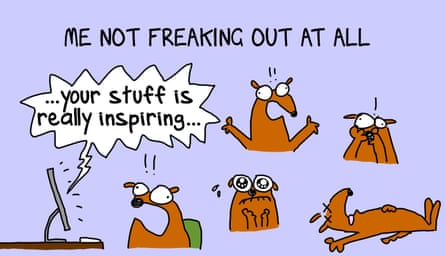
(Has actual myocardial infarction, calls ambulance) Thank you very much indeed – I am just going to be speechless for a moment. It’s a real honour that not only have you read my cartoons, but you also like them.
No, I really like them. You know, I drew my comic strip Life in Hell for 32 years and, uh, then I got fired by too many papers and I stopped … But yeah, I miss it, and I like what you do. A lot.
I know you’re hugely busy, but surely if you want to draw Life in Hell again you can just do it and tell people they have to print it.
Well, you know, we just finished our 600th episode of The Simpsons a week ago, and animation doesn’t get any easier – it’s amazing how much sustained attention it requires. And maybe I’m kidding myself, but I like to think that my scrutiny makes a difference.
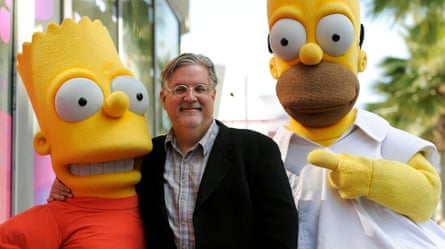
So how hands-on are you with The Simpsons?
I work on it full time. What’s great about being in my position is I get to show up whenever I want to and sit in, mostly with the writers, and just pitch jokes along with the rest of them.
Do you work in animation?
Not really. I would like to, but as you pointed out it is very time consuming.
Very time consuming, and the best thing to do is get other people to do the hard work. It needs sustained attention; it’s amazing how wrong things can go in animation. Whenever I see a piece of animation, a TV show or movie that doesn’t work, I feel so bad, because I know how many tears and how many drops of blood went into that, into those projects. And you can’t always get the tone right – that’s the hardest part. It’s a painful process.
When you get to work with a group of people who are incredible collaborators, then it’s a little more relaxing. Back at the beginning of The Simpsons, I used to go home after working until the middle of the night and still not be able to sleep, because I was so worried about the problems that we were going to be facing the next day. I actually get a good night’s sleep these days, so that’s pretty good. And we’re pretty confident that we can deliver the jokes.
By the way, I’m really looking forward to coming to Australia because – just based on fan mail and occasional encounters with Australians – it seems like the country where The Simpsons has the most fanatical fans. They just really really dig it, and it makes me really happy because they’re watching the show in its original language.
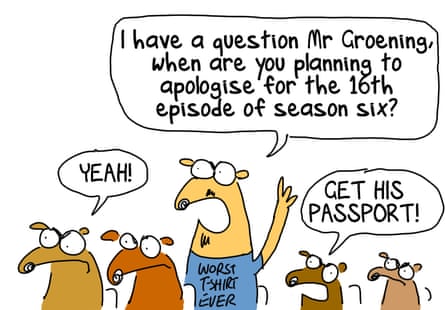
When I hear fans from Brazil or Argentina or wherever, I’m always wondering: are they laughing at our jokes, or are they laughing at the Portuguese- or Spanish-speaking actors who are dubbing it into another language? You guys are getting it unadulterated!
The Australian Simpsons episode, Bart vs Australia, had a big impact here. I think it was partly joy at being recognised in an episode of The Simpsons, but then also outrage at everything you probably deliberately got wrong … There’s a campaign to rename our currency “Dollarydoos”.
Well, the feeling at the time was, “We know we can’t get Australia correct, so let’s go the other way. Let’s get everything as wrong as possible” – thinking that you guys would all understand our idiocy, and realise that it was us being intentionally stupid.
But you know, I have mixed feelings about it. I am not particularly happy with that episode. I wish we’d tried a little bit harder. But whatever, that’s a long time ago.
Perhaps you could review it because you’re going to get a lot of questions about it when you come here.
OK, I will review it. Is there a single correct observation in the entire show? I don’t think so.
I’m not sure there was.
Australia is not the only country that we have upset, by the way. We clearly annoyed the minister of tourism in Brazil for the way we depicted Rio de Janeiro. And then we did an episode for the World Cup in Brazil, and we correctly predicted bribery and payoffs and corruption – and we were just making that up too.
And Donald Trump? Were you just being prescient, or did you summon his presidential candidacy into being by raising it?
We predicted that he would be president back in 2000 – but [Trump] was of course the most absurd placeholder joke name that we could think of at the time, and that’s still true. It’s beyond satire.

We did one online piece of animation when Trump announced his candidacy, when he was going down the escalator we had Homer actually follow him on the escalator and we went into a fantasy of what was happening inside Trump’s hair. But we’ve been trying to figure out how to do more and it’s really hard.
If by chance he gets elected, which I doubt highly will happen, I think we’ll suddenly be very inspired. Mr Trump’s election, as horrible as it would be, would be great for comedy – as comedians always say …
One of the things that occurs to me is the sober writing of political history is impossible for this election. When historians are writing about this election, after all of the other presidents, it’s the worst. Just quoting from it would be like a clown show. It’s just the most amazing thing. And I’m hopeful that this is just an aberration but I don’t think it will be. There’s a certain lack of civility and common sense, a complete exaggeration of name calling and triviality [that] is just astounding. And it may be here to stay. We shall see.
If Trump wins there will be an exodus of people. I won’t [leave the US] because I actually think it will be amazing in all its horror.
You’re coming to Graphic and doing a session on The Simpsons, and also one with your friend, the cartoonist and writer Lynda Barry. What can we expect from that conversation?
She and I went to college together and we do a tandem talk about growing up and how our childhoods were similar and different – and at one point she and I read some of my strips [from Life in Hell] together …
I was doing strips in which the characters stayed in exactly the same positions from frame to frame, and the only thing that changed were their expressions and the dialogue. It plays like a very primitive form of animation when you see it on the big screen. And it is quite gratifying for me, to read these comic strips and get a laugh, you know.
I always thought – and I see this in your stuff too – that you’re holding the reader’s eye on the page so that the dialogue [works]. You can’t just go to the last frame and get the punchline; you need to be led through the strip. That’s one reason why Life in Hell was so dense at the beginning: I was in weekly newspapers and I felt I only got a crack at getting people to look at my stuff once a week, so I was going to make it so they really had to work at it in order to get the joke. And as years went by, and I had more things to do, I simplified my style.
And also, man, after doing things a certain way it’s fun to mix it up a little.
That’s Python’s “the tyranny of the punchline”, isn’t it? I often struggle if I have to come up with a punchline, whereas if I put 20 sort of vaguely funny jokes into one cartoon and you add them all together, it’s actually possibly funnier. Well, that’s one way of working anyway.
I agree completely: you make getting there the fun part; you just don’t want to let the air out of the tyre for the last frame, that’s all.
A lot of animated cartoons – the great Warner Brother cartoons, Bugs Bunny and all those – they’re brilliant. Generally the last gag of the cartoon is a complete misfire, but you still go, “That was brilliant.” You know, getting there was great.
Although I have to say, for the most part when writing a comic strip I do know where I’m going before I start drawing. Occasionally I change my mind along the way; as I’m pencilling the strip, I sometimes come up with a better joke at the end.
I love pacing and timing and it’s fun – comics are definitely their own medium. It’s not animation, it’s not a single panel; you’re capturing time. And partly that time is the time it takes to read the dialogue balloons.
Getting back to your stuff – that’s why I like your stuff so much: I like the journey, I like the story.
(Grinning like an idiot) Do you have any pets?
Pets? I have had pets. Right now we have a pet salamander named Ramone. At the moment that’s all we have. But we’ll be getting more. Over the years I’ve had cats and dogs. I have a house full of kids, I have two 10-month-old twin daughters and a three-year-old son as well, so the house is full.
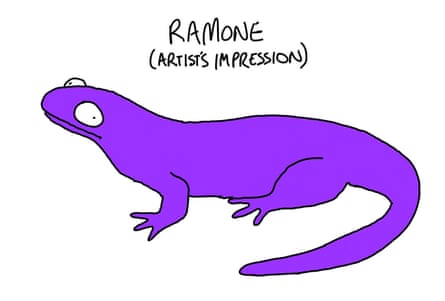
You’re hugely successful, with a back catalogue you can see from outer space, but do you ever think it will one day be enough? Bill Watterson [Calvin and Hobbes] and Gary Larson [The Far Side] gave it up. Is there a point where you just want to say, “I can go and sit on a beach and look at the children and talk to my new dog that I’m going to get?”
I could easily stop and have a completely fulfilling life reading books and scuba diving and all the rest of that stuff, but I still am having such a blast making up stories and working with people – I don’t feel like doing that. It’s really fun to make up stories and tell jokes. It’s really an extension of child’s play. The same kind of joy I got as a kid, making up worlds and drawing dinosaur battles and all the rest, you know? That was a blast. And in a way I was able to never leave that behind, I still get to do it. And that’s the fun part.
You mention Watterson and Larson – well, first of all they did daily strips, or daily cartoons, or whatever you would call Larson’s Far Side. And I think that’s just such a grind. I was told a story that Gary Larson had to go on book tours and they would set up a drawing table for him in the hotel room after he got done with his hours-long book signings. And I thought, that sounds like such a nightmare.
We had Gary Larson on The Simpsons playing himself [Once Upon a Time in Springfield] and that was amazing. To me he is one of the great legends, and I certainly miss Calvin and Hobbes – I think that was one of the best comic strips of all time.
Watterson had the skill to make some very dark satire uplifting and hopeful. What is the most hopeful or beautiful thing you’ve worked on?
My favourite stuff that I’ve ever done is taking my children’s actual words and illustrating them. I have two sons named Will and Abe and when they were younger I recorded their conversations, and then I would illustrate it. And it’s the funniest, sweetest stuff – it makes me laugh, maybe because my ego is taken out of it.
Yeah, that’s the stuff I love the most.
And The Simpsons? The world is a terrible place and essentially the job of a cartoonist seems to be finding fault so you can make fun of it. It is a lot darker.
Well at The Simpsons, we just try to make sure that whatever the story is, it is ultimately a celebration of the family, even if families drive you crazy … We’re trying to do a family show in the broadest sense: that there are jokes for different members of the family – there are jokes that little kids will love and there are jokes that they won’t get at all. And what we figured out a long time ago, partly through luck, is that it doesn’t matter. Every joke doesn’t have to be understood by every member of a family. As long as you keep it moving fast you can have a rude joke that makes a 13-year-old boy laugh, and makes the uptight grandparents maybe purse his or her lips a little but not leave, or not change the channel.
The end
(There was a lot more; we were only supposed to talk for half an hour but we just went on and on. And then he invited me to dinner at his house next time I am in the US. No he really did.)

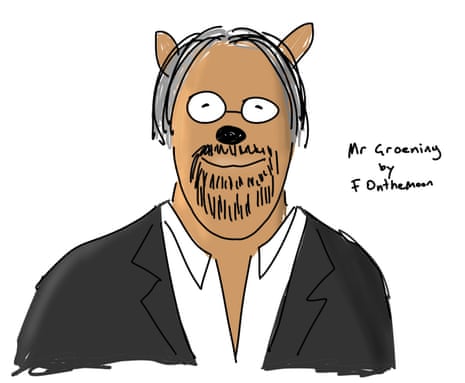
Comments (…)
Sign in or create your Guardian account to join the discussion